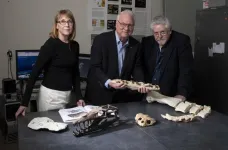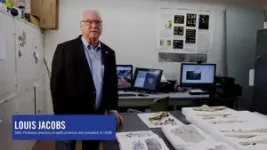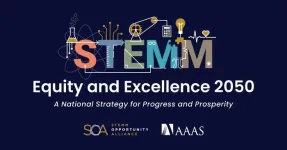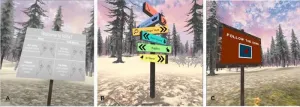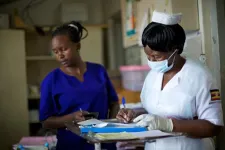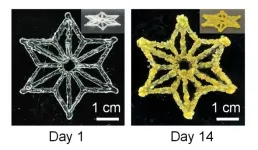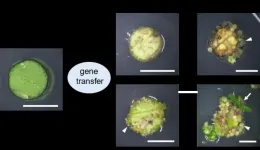(Press-News.org) DALLAS (SMU) – An SMU-led research team has found that ancient rocks and fossils from long-extinct marine reptiles in Angola clearly show a key part of Earth’s past – the splitting of South America and Africa and the subsequent formation of the South Atlantic Ocean.
With their easily visualized “jigsaw-puzzle fit,” it has long been known that the western coast of Africa and the eastern coast of South America once nestled together in the supercontinent Gondwana — which broke off from the larger landmass of Pangea.
The research team says the southern coast of Angola, where they dug up the samples, arguably provides the most complete geological record ever recorded on land of the two continents moving apart and the opening of the South Atlantic Ocean. Rocks and fossils found date back from 130 million years ago to 71 million years.
“There are places that you can go to in South America, for instance, where you can see this part of the split or that part of it, but in Angola, it's all laid out in one place,” said Louis L. Jacobs, SMU professor emeritus of Earth Sciences and president of ISEM. Jacobs is the lead author of a study published in The Geological Society, London, Special Publications.
“Before this, there was not a place known to go and see the rocks on the surface that really reflected the opening of the South Atlantic Ocean, because they’re now in the ocean or eroded away,” Jacobs said.
Angola rocks and fossils tell the whole story
Africa and South America started to split around 140 million years ago, causing gashes in Earth’s crust called rifts to open up along pre-existing weaknesses. As the tectonic plates beneath South America and Africa moved apart, magma from the Earth’s mantle rose to the surface, creating a new oceanic crust and pushing the continents away from each other. And eventually, the South Atlantic Ocean filled the void between these two newly-formed continents.
Scientists have previously found evidence of these events through geophysics and well cores drilled through the ocean floor.
But these tell-tale signs have never been found in one place, or been so clearly visible for anyone to see, said study co-author Michael J. Polcyn, research associate in the Huffington Department of Earth Sciences and senior research fellow, ISEM at SMU.
“It's one thing for a geophysicist to be able to look at seismic data and make inferences from that,” he said. “It's quite another thing to be able to take a school field trip out to the rock formations, or outcrops, and say this is when the lava was spreading from eastern South America. Or this was when it was a continuous land.”
Essentially, Angola presents the opportunity for someone to easily walk through each phase of this geologically significant chapter in Earth’s history.
“That gives Angola major bragging rights,” Jacobs said.
Jacobs, Polcyn and Diana P. Vineyard – who is a research associate at SMU – worked with an international team of paleontologists, geologists and others to analyze both the rock formations they found in eight different locations on the coast and the fossils within them.
Fieldwork in Angola’s Namibe Province began in 2005. At that time, the research team recognized particular types of sediments, which gave them a good indication of what the western coast of Africa had been like at various stages millions of years ago. For instance, fields of lava revealed volcanic outpourings, and faults or breaks showed where the continents were being rifted apart. Sediments and salt deposits showed ocean flooding and evaporation, while overlying oceanic sediments and marine reptiles showed completion of the South Atlantic Ocean.
Paleontologists, meanwhile, discovered fossils in Angola from large marine reptiles that had lived late during the Cretaceous Period, right after the Atlantic Ocean was completed and while it grew wider.
By bringing together experts from a wide range of fields, “we were able to document when there was no ocean at all, to when there was a fresh enough ocean for those reptiles to thrive and have enough to eat,” Vineyard said.
Many of the ancient fossils are currently on display at the Smithsonian’s National Museum of Natural History “Sea Monsters Unearthed: Life in Angola’s Ancient Seas” exhibit, which was co-produced with SMU – a nationally-ranked Dallas-based private university.
Angolan researchers – Nair de Sousa, a geoscientist and energy consultant at the African Circular Business Alliance, and Pedro Claude Nsungani, a geology professor at the Universidade Agostinho Neto – also played a key role in this research.
About SMU
SMU is the nationally ranked global research university in the dynamic city of Dallas. SMU’s alumni, faculty and more than 12,000 students in eight degree-granting schools demonstrate an entrepreneurial spirit as they lead change in their professions, communities and the world.
END
Rock solid evidence: Angola geology reveals prehistoric split between South America and Africa
2024-05-01
ELSE PRESS RELEASES FROM THIS DATE:
Life expectancy in two disadvantaged areas higher than expected
2024-05-01
Better than expected life expectancy in two disadvantaged areas in England is probably due to population change according to local residents and professionals.
In the UK, people from the most disadvantaged areas can expect to die nine years earlier compared with people from the least disadvantaged areas while people in the north of England have lower life expectancy, higher infant mortality and worse health and wellbeing compared with national averages.
The study, funded by the NIHR School for Public Health Research, was a collaboration between Lancaster University, ...
Dynamic DNA structures and the formation of memory
2024-05-01
An international collaborative research team, including scientists from UQ’s Queensland Brain Institute (QBI), has discovered a novel mechanism underlying memory involving rapid changes in a specific DNA structure.
The team found that G-quadraplex DNA (G4-DNA) accumulates in neurons and dynamically controls the activation and repression of genes underlying long-term memory formation.
In addition, using advanced CRISPR-based gene editing technology, the team revealed the causal mechanism underlying the regulation ...
STEMM Opportunity Alliance releases national strategy at White House summit to diversify and expand STEMM workforce by 2050
2024-05-01
WASHINGTON, D.C. – Today, the STEMM Opportunity Alliance (SOA) announced STEMM Equity and Excellence 2050: A National Strategy for Progress and Prosperity at the 2024 White House Summit on STEMM Equity and Excellence, co-hosted by the White House Office of Science and Technology Policy (OSTP). The overarching goal of the national strategy is to help 20 million people from historically excluded and marginalized communities enter, contribute to, and thrive in Science, Technology, Engineering, Mathematics and Medical (STEMM) fields.
SOA ...
Calcium can protect potato plants from bacterial wilt
2024-05-01
Washington, D.C.—Scientists have discovered that calcium plays a significant role in enhancing the resistance of potato plants to bacterial wilt. This disease causes worldwide losses of potatoes costing $19 billion per year. The findings open up new avenues for integrated disease management strategies, including the potential for calcium amendments to soil as a part of a comprehensive approach to controlling bacterial wilt in potatoes. The study is published in Applied and Environmental Microbiology, a journal of the American Society for Microbiology.
Ralstonia solanacearum species complex (RSSC) is a phytopathogenic bacterial group that causes bacterial wilt in ...
Virtual reality environment for teens may offer an accessible, affordable way to reduce stress
2024-05-01
Social media. The climate crisis. Political polarization. The tumult of a pandemic and online learning. Teens today are dealing with unprecedented stressors, and over the past decade their mental health has been in sustained decline. Levels of anxiety and depression rose after the onset of the COVID-19 pandemic. Compounding the problem is a shortage of mental health providers — for every 100,000 children in the U.S., there are only 14 child and adolescent psychiatrists.
In response to this crisis, University of Washington researchers studied whether virtual reality might help reduce stress ...
Join us in honoring the 2024 American Gastroenterological Association Recognition Awards recipients
2024-05-01
Bethesda, MD (May 1, 2024) — The American Gastroenterological Association (AGA) has announced the 2024 recipients of its annual recognition prizes, given in honor of outstanding contributions and achievements in gastroenterology.
"AGA is delighted to present the recipients chosen for the 2024 AGA Recognition Prizes. We extend our gratitude to all the nominators for their submission of nomination letters, and to the diligent selection committee members for their work in identifying these exceptional individuals from ...
Resource-appropriate cancer care, including coexisting health issues of HIV and cancer, to be addressed during meeting in Nairobi
2024-05-01
NAIROBI, KENYA [May 1, 2024] — Local and global experts are meeting in Nairobi, Kenya to update clinical practice guidelines as part of ongoing work with Allied Against Cancer—a collaboration between the National Comprehensive Cancer Network® (NCCN®), African Cancer Coalition (ACC), American Cancer Society (ACS), and Clinton Health Access Initiative (CHAI). The meeting brings together subject matter experts to update NCCN Harmonized Guidelines™ for Sub-Saharan Africa, featuring updates for treating cancer in people with HIV and other important ...
Marriage of synthetic biology and 3D printing produces programmable living materials
2024-05-01
Scientists are harnessing cells to make new types of materials that can grow, repair themselves and even respond to their environment. These solid “engineered living materials” are made by embedding cells in an inanimate matrix that’s formed in a desired shape. Now, researchers report in ACS Central Science that they have 3D printed a bioink containing plant cells that were then genetically modified, producing programmable materials. Applications could someday include biomanufacturing and sustainable construction.
Recently, researchers have been developing engineered living materials, primarily relying on bacterial ...
Friends with health benefits: How the buddy system pays off when pursuing goals
2024-05-01
Weekly targets, annual resolutions, five-year plans—all of them so troublingly elusive. With best intentions, most of us fail to stick with the goals we set.
Next time, consider pursuing them with a friend.
New field research by Assistant Professor Rachel Gershon, published in Management Science, suggests that pursuing our goals with friends may make them more attainable. Gershon, along with Cynthia Cryder of Washington University and Katy Milkman of the University of Pennsylvania, ...
Novel genetic plant regeneration approach without the application of phytohormones
2024-05-01
For ages now, plants have been the primary source of nutrition for animals and mankind. Additionally, plants are used for the extraction of various medicinal and therapeutic compounds. However, their indiscriminate use, along with the rising demand for food, underscores the need for novel plant breeding practices. Advances in plant biotechnology can address the problems associated with food scarcity in the future by enabling the production of genetically modified (GM) plants with higher productivity and resilience to the changing climate.
Naturally, plants can regenerate an entire new plant from a single ‘totipotent’ cell (a cell that ...
